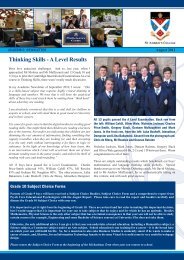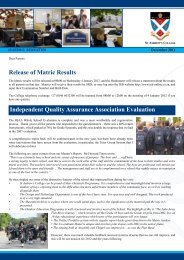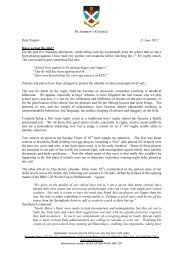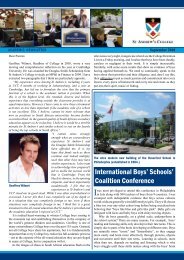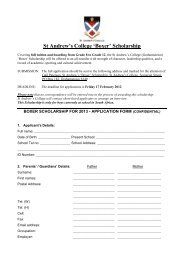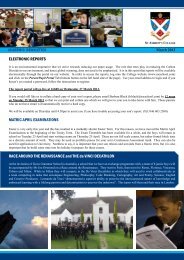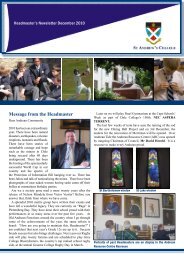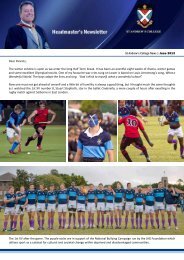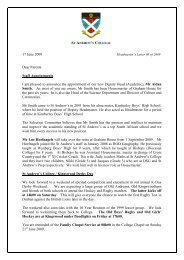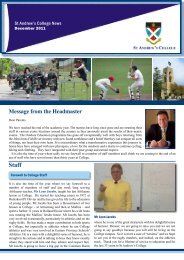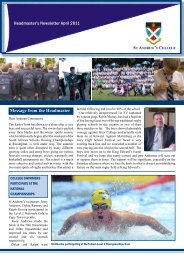Innovation resource pack - Design Museum
Innovation resource pack - Design Museum
Innovation resource pack - Design Museum
- No tags were found...
You also want an ePaper? Increase the reach of your titles
YUMPU automatically turns print PDFs into web optimized ePapers that Google loves.
<strong>Innovation</strong>TUsingfor teachers’ notesthis Resource Pack➜During the last decade of thetwentieth century, globalcommunications and rapid changesin technology transformed ourworking practices, replacing stabilityand routine with risk and uncertainty.The ability to be flexible and creativewill be more important for the futurethan traditional academic learning.This <strong>Design</strong> <strong>Museum</strong> ResourcePack is for teachers and students atKey Stage 3 and above. It aims tohelp students increase the qualityand quantity of their ideas throughsimple, hands-on activities that drawon the practices of contemporarydesign consultancies andmanufacturers.Guide to using activity sheetsA Activity 1 – Keeping an open mindThese riddles and puzzles help students deferjudgement. They can be used individually as interimactivities for students to do between other projects, ortogether as a preparation to put them in the right frameof mind for creative thinking.SolutionsBrain teasers:1. His parachute has failed to open.2. They are goldfish whose bowl fell off the window sill.3. Four seconds. If the time between the clapperstriking the bell for the first peal and the second peal istwo seconds, then it will be a further two secondsbefore it strikes for the third peal.xMatchlessxx• • •• • •• • •Join the dotsAims and contentsThe <strong>pack</strong> introduces the strategies central to creativethinking and provides practical guidance on putting theminto effect. The information sheets and activities aredesigned to help students keep an open mind, work inteams and understand the importance of user evaluation.The main message should be that designers andmanufacturers define their customers’ needs and theconcept clearly before they design.Other triggers for innovation, including the study ofergonomics, new materials and manufacturing methods,inspiration, reconfiguring and technical expertise arediscussed. Suggestions for assembling a handlingcollection for use in the classroom complete the <strong>pack</strong>.The different sheets directly relate to each other andthe information and ideas on them sometimes overlap.The <strong>Innovation</strong> sections from other <strong>resource</strong> <strong>pack</strong>s inthis series can also be combined with the contents ofthis <strong>pack</strong> to form a comprehensive <strong>resource</strong>.Technical terms are explained in the ‘buzz words’ boxat the end of each section.31Square bashingClean cut (ii)Clean cut (i)Clean cut (iii)To order additional <strong>pack</strong>s or for more infomation about the <strong>Design</strong> <strong>Museum</strong> Education Programme, please contact: Education Department, <strong>Design</strong> <strong>Museum</strong>, 28 Shad Thames, London SE1 2YD.www.designmuseum.org Tel 020 7403 6933. Fax 020 7378 6540. Email education@designmuseum.org.uk
<strong>Innovation</strong>FeedbackUsing the evaluation sheets, point out to the studentsthe ways in which they have jumped to conclusionsand made assumptions. Ask them to assume the‘lateral thinking’ mind set when tackling the next activity.A Activity 2 – Working togetherThese activities will help acclimatise students toworking in a group. You can use them as ‘warm-ups’for group tasks or as discrete activities to support otherareas of the curriculum (e.g. structures). Allow 20minutes for each exercise.The main point of the task is to get the students towork together to solve a problem. You will be able tosee an obvious solution to these familiar exercises –indeed, you may prefer to substitute your own – but thepurpose here is to bond the students as a team, not tofind the optimum structural solution. Resist thetemptation to make suggestions!FeedbackAsk the students to consider their working methods,using the evaluation sheets. Did they divide up thetasks efficiently? Did they spend too much timeplanning and not enough making? The lessons to belearned here are the value of teamwork and theadvantages of rapid prototyping (see also Activity 7).A Activities 3 and 4 – Understanding the userThese introduce user evaluation and show studentsthat the most effective way to research is to assess theneeds of the user.A Activity 3 – Whose life is it?This proves to students how much information they canglean by careful observation and analysis.For this exercise you need to ask people of differentages and lifestyles to take a roll of film of a day in theirlives, leaving themselves out of the pictures. You willneed to provide a set of photos (minimum a dozenpictures in each) for each group of four students. Allow20–30 minutes for the exercise.A Activity 4 – Understanding the userThis can be used to focus pupils directly on a productthey will be designing, or it can be a general userevaluationexercise. Allow an hour for this.A Activity 5 – BrainstormingOnce the ground rules have been set out and studentsare in the right frame of mind, it is time to move on tobrainstorming ideas.You may already have asked students to consider thegeneral theme of a project in Activity 4. Activity 5follows on directly from it, identifying and logging ideaswhich will have arisen during user evaluation. Allow 30minutes for the exercise.The most important features of a successfulbrainstorm are that ideas are not filtered or evaluated inany way; and that every idea is worthy of considerationand is recorded. It is very important that each grouphas a fair-minded scribe who ensures that thishappens.A Activity 6 – Developing ideasAsk the students to put all their brainstorming sheetson the wall. Give them five Post-it notes each to votefor the best ideas.Activity 6 is intended to get students to think in thesame creative way about development. They may findthis difficult; encourage them to try unusualcombinations and modifications rather than simplestyling changes. Allow 35 minutes for the exercise.A Activity 7 – Rapid prototypingAllow about 45 minutes for Activity 7. The time limit ismost important: allowing a long time will make studentstoo particular about the appearance of the outcome.Remind them of the lessons about teamwork learned inActivity 2 and get them working in 3D as soon aspossible. It may be a good idea to have the rules forrapid prototyping on display. It is very important to havethe widest possible range of materials available.Working in groups helps students with difficult parts ofthe design process such as the design brief andgenerating and developing ideas. Once familiar withcreative thinking strategies they will be able to applythem when working individually.D for designing 2 describes professional strategies fordeveloping design concepts.D for designing 1 offers real-life examples of creative thinkingand teamwork from industry.Activities 3-7 were inspired by the ‘Deep Dive’ innovation process developed by IDEO© <strong>Design</strong> <strong>Museum</strong> 2001
DDefiningfor designing 1the concept<strong>Innovation</strong>➜The concept, or initial brief for aproduct, is carefully worked out beforeany design work is done. <strong>Design</strong>ers andmanufacturers work in teams, thoroughlyresearching the target market andconsidering all possible solutions.Keeping an open mindWhen designing, we sometimes filter our ideas beforedrawing them. Creative people consider a broad rangeof possibilities. In doing so they are able to linkunrelated subject areas to produce new ideas. This isalso called lateral thinking or ‘technology transfer’.AActivity 1 will help you avoid jumping to conclusions.Case study:VELCRO ®brand fastenersA Swiss engineer called George de Mestralwas out walking his dog when he becameintrigued by the way burs (prickly seed pods)clung tightly to his clothing and his dog’sfur. He immediately thought that hooks andloops might provide an alternative to theawkward and expensive zip fastener. Heworked with a weaver for eight years todevelop it.The loop tape requiredonly a loosely wovenfabric; the hooks,however, were moredifficult to produce.Finally, by trial and error,de Mestral found thatnylon forms toughhooks when sewnunder ultraviolet light.He patented the designin 1955 and was soonselling 60 million metresof VELCRO ® brandfasteners a year.VELCRO ® is a registeredtrademark of Velcro Industries B.V.Case study:Maclaren BuggyOwen Finlay Maclaren MBE, a retiredtest pilot and aeronautical designer, wasinspired to redesign the pushchair afterthe birth of his grandchild. He used thetechnology and materials familiar tohim from the aeronautics industry –lightweight aluminium tube andresilient balloon-foam tyres.Another example of‘technology transfer’was the use of theumbrella-foldingmechanism tocondense the Buggyinto a neat tubularshape. The MaclarenBuggy weighed lessthan 3kg and could beslung over one armwhen folded. It was firstsold in 1967.A multi-disciplinaryteam from internationaldesign consultancyIDEO working on theconcept for a productA How much of ateam player are you?Find out in Activity 2.Working togetherStudent projects differ in many ways from industrialpractice. In industry, creating and developing a conceptfor a product is carried out by multi-disciplinary teamsincluding experts in design, marketing, finance, procurementand production engineering. Then each departmentworks independently on the development of the product,coming together regularly for progress up-dates.
<strong>Innovation</strong>“UnderstandingStepping into theshoes of others meansnever forgetting weare designing for peopleother than ourselvesBill Moggridge and Tim Brown, IDEOCase study:Shopping Cart by IDEO”International design consultancy IDEO always begin withtotal immersion in the world of the user. For their shoppingtrolley they used current models in supermarketsthemselves and talked to shoppers, cashiers, managersand trolley collectors. They photographed and filmed usersat every stage, including the way children rode on trolleysand how people carried their shopping away. They lookedat the problem of trolley theft and incorporated a solutioninto their design.•ScannerSnap-in safety bar•with play surfacethe userHaving a clear picture of a problemis halfway to solving it. In industrymuch time, money and effort isspent on understanding the user,establishing what his/her needs areand looking at how he/shebehaves, thinks and feels.A Activity 3 tests how much you canfind out about someone from very littleevidence.A Activity 4 makes you think about howyou do things, and how other people dothem quite differently!Links …Websites:Alessi: www.alessi.comFord: www.designmuseum.orgGo to ‘Education’. Select ‘Resources’, then‘Primary/ Secondary’ and download ‘The<strong>Design</strong> Process at Ford Motor Company’<strong>resource</strong> <strong>pack</strong>IDEO: www.ideo.comMaclaren Buggy:www.maclarenstrollers.com2pm: www.2pm.co.ukVelcro: www.velcro.comAnother example of technology transfer:www.flymo.comBooks:Alberto Alessi, The Dream Factory: Alessisince 1921, Electra/Alessi, 2001Tom Kelley with Jonathan Littman, The Art of<strong>Innovation</strong>, Lessons in Creativity from IDEO,Doubleday, 2001Fay Sweet, Alessi: Art and Poetry, Thamesand Hudson, 1998•••Baby seatFrame to holdsix standardhand basketsHooks for plasticbags to carryshopping fromcheckout•Empty cart is justa frame to deterthievesForward and sidemotion wheels•© <strong>Design</strong> <strong>Museum</strong> 2001
<strong>Innovation</strong>Dfor designing 2Making ideas happenIt is possible to find interesting andcreative solutions to even the mostmundane problems, as the examples onthis sheet demonstrate. You can avoidthe obvious and find an original solutionif you do not make assumptions at thestart about how the product should look.BrainstormingBrainstorming can produce an amazing variety of innovativeideas: the most interesting and radical products canoriginate from a well-conducted brainstorm. The aim is toproduce the widest possible range of new ideas in the leasttime. There is no place here for painstaking drawings onordered sheets: instead you are making ‘mind maps’.AActivity 5 includes rules for successful brainstorming.A After brainstorming certain strong ideas or themes emerge.Activity 6 will help you choose the best to take to the next stage.Case study:Eco Bin by 2pm➜How often do you see a stylish waste binwhose appearance is spoiled by the use ofa plastic bag to keep it clean? StewartRobbins’ design is in two parts; the lowerpart has lugs on the side over which youhook the plastic bag handles. Then thetop half slips over to hide the unsightly bag.The starting point forthe design idea wasnot appearance,however, but thematerial and themanufacturing process.Product designers 2pmspecialise in flat<strong>pack</strong>designs inpolypropylene sheet.All their products are,in effect, nets ordevelopments whichthe customer folds andjoins using integralslots and flaps. Thetwo parts of the bin aresupplied flat and arefixed into cylindricalshapes by finger jointsalong the edges. Otherexamples from 2pm’srange are a bird houseand a lamp.•➜ What is it? A tough and flexible thermoplastic.➜ Characteristics Strong and resilient and will bendwithout splitting.The CDs fit snuglybetween the pegsSoundtrack CD Holder by AlessiCD storage is often the subject of student projects andsome of the results can be a little predictable, to saythe least. <strong>Design</strong>ed by Ron Arad, this Alessi CD holderis sold rolled up in a CD case. It can be unrolled andstuck down to a surface with double-sided tape.Data FILE: Polypropylene➜ Best-known application Stackable chairs, based onan original design by Robin Day (1962–3), now found inevery school and college around the country.➜ Manufacturing processes Usually injectionmoulded,but also used in sheet form for ring binders andcovers. 2pm products are die-cut (stamped out with ashaped tool like a biscuit cutter).
<strong>Innovation</strong>Case study: CAD/CAMat Ford<strong>Design</strong>ers and engineersat Ford use computer-aideddesign and manufacture(CAD/CAM) to model theirideas, not sketches orhand-made prototypes.<strong>Design</strong> ideas are drawn onscreenand can be rotated inany direction. All the necessarymeasurements can be fed intothe computer, even the spaceto allow a spanner to get in andtighten a bolt. At any point adesigner in any part of the worldcan command a clay model tobe produced on computer-aidedmills in Britain and Germany.This is rapid prototyping ona worldwide scale.A designer using a CAD program.The image can be rotated on the screen.A computer-aided milling machinecutting a clay model.Developing ideasWhen you have chosen the best ideas from your brainstorm,you may need to sketch to combine or modify them. Whenyou have one or two good ideas to develop, you can start tomodel them.“Engineers … onlyever make one changeat a time … It is the onlyway of knowing if thechange has made animprovement. James Dyson”Rapid prototypingOnce the strongest idea has been chosen it mustbe developed in sketch or model form. StewartRobbins of 2pm prototypes flat<strong>pack</strong> designsusing a CAD program and cuts the shape ona plotter fitted with a scalpel instead of a pen.Foam model of DC07Buzz wordsFlat<strong>pack</strong> – a product sold as a kit ofparts to be assembled by the customer.The parts are sometimes, but notalways, flat.Injection moulding – a manufacturingprocess used to make complex shapesfrom thermoplastics. Plastic powderis heated until it becomes liquid andis squeezed under pressure into amould, which may be in several parts toallow the moulding to be removedwhen set. Injection moulding is veryquick and many thousands of items anhour may be produced.Integral – included in the main structureof the item; not added afterwardsLateral thinking – using intuition orinstinct to produce original andunusual ideas.Lug – a part of an object which sticksout and by which it can be connected,supported or lifted.Mill – a machine used to carve3D models.Modelling – trying out an idea on paper,computer or in 3D.Net or development - a 3D shapewhich is flattened by opening it outalong its seams. It may show fold linesand joining flaps or slots.Plotter – a machine which draws animage from a computer screen.Procurement – arranging for the rightparts and materials to be suppliedto the factory.Production engineering – designingand adapting machinery and systemsto manufacture a product.Prototyping – making a model todevelop an idea.Resilient – able to regain an originalshape or position after being pressed,stretched or bent.Technology transfer – usingknowledge about one subject to solvea problem in another.Thermoplastic – a group of commonlyused plastics which soften when heated.Thermoplastics are used for a widevariety of products such as householdcontainers (polyethylene, or polythene forshort), plastic <strong>pack</strong>aging (polystyrene),toys and household appliances (ABS)and double glazing (PVC).A design and technology teacherprototypes a ‘waking-up device’ at a<strong>Design</strong> <strong>Museum</strong> workshop with IDEO,world leaders in innovation.A Activity 7 guides you through theprocess of rapid prototyping.© <strong>Design</strong> <strong>Museum</strong> 2001
<strong>Innovation</strong>IHowfor innovationelse do new ideas come about?“Innovative companies share certaincharacteristics: they see user evaluationas central to their success; they work inmulti-disciplinary teams; they movealmost immediately into prototyping.More and more manufacturers arerethinking how they use their workforceto encourage innovation. James Dyson,for example, makes engineers anddesigners central to his company.Why should companies be ledby accountants, lawyers andsalesmen? Empoweringengineers means that teamleaders provide inspiration,not just balance sheets.James Dyson”D For the ways in which innovative companies originateand develop their ideas, see D for designing.➜Case study: Dyson Dual Cyclonevacuum cleanerJames Dyson thought that the cyclone filter in his factorymight work better than the filter bag in his ineffectivevacuum cleaner. The way he went about exploring his ideais similar to how his engineers develop products today.1. Establish exactly what theuser wantsDyson engineers are involved withcustomer care and listen to whatcustomers say.2. Define the conceptThey write a brief which combinestheir suggestions with those ofusers.3. Brainstorm itThey then produce a large numberof sketches in order to select theideas they are going to develop.4. Clarify …A detailed design specificationsets out the key features. Function,safety, materials, productionprocesses, ergonomics, aestheticsand cost are all important.5. Prototype itDyson engineers only make one changeat a time as they prototype. They modelin card and foam and test circuitsusing ‘breadboards’.Working ‘breadboard’ prototype of DC026. Test at every stageWhen the stairhugging versionof the DC02 was being developed,engineers built a staircase inthe factory to test it.Blue foam prototype of DC027. Use other people’s know-howDyson engineers develop productswith scientists, make financialdecisions and get involved withevery step of design andmanufacture.
<strong>Innovation</strong>There are othermethods and startingpoints for innovation.ReconfiguringMajor manufacturers cannot takerisks too often and may modifysuccessful products to meet newrequirements or a different market.This is called ‘reconfiguring’ or‘incremental innovation’.The Russell Hobbs K1 kettle(1956) was the first automaticelectric kettle. Its popular andradical design remained almost thesame for 20 years, apart from thereplacement of the chrome-platedcopper body with a stainless-steelone. The K2 ‘Country Style’version of the 1970s reflectedpublic taste for natural materialsand rustic images in the wakeof the hippy movement.The K2 continues to beproduced today.Technical expertiseSometimes people with specialistknowledge work with designersto produce original solutions.<strong>Design</strong>er Jonathan Savitt anddentist Dr Charles Taylor set out tostop the accumulation of debris atthe base of toothbrush bristles,which encourages the growth ofbacteria. Their O-zone toothbrushhas a hole in the middle, removingthe troublesome area to allowthorough rinsing of the bristles. Theshape also encourages the user tobrush at the correct 45-degree angle.InspirationThe ‘Eureka’ moment is rare.It usually comes about after aperiod of concentrated work whenthe mind is relaxed and thinkingabout something else.In a restaurant on the Isle ofCapri, designer Philippe Starck wasabout to tuck into a plate of squidgarnished with lemon slices whenhe suddenly had an idea thatcombined these elements with asuggestion of alien life forms. Hedrew it on his napkin and the JuicySalif lemon squeezer was put intoproduction by Italian manufacturersAlessi shortly afterwards.Links …Websites:Alessi: www.alessi.comApple: www.apple.comDyson: www.dyson.comExploring <strong>Innovation</strong>: www.brunel.ac.uk/research/exploringO-zone toothbrush: www.ozonetoothbrush.comBooks:Brunel University and The <strong>Design</strong> Council, Exploring <strong>Design</strong>and <strong>Innovation</strong>, Brunel University, 2000Judith Camel-Arthur, Philippe Starck, Carlton, 1999Edward de Bono, Serious Creativity, HarperCollins, 1996Simone Philippi and Philippe Starck, Starck, Taschen, 2000Fay Sweet, Philippe Starck, Subversive <strong>Design</strong>,Thames & Hudson, 1999Biography:PHILIPPE STARCKBorn 1949 in Paris.Interests <strong>Design</strong>s interiors,furniture and products.Well-known designs Hot Bertaakettle, Juicy Salif lemon juicer (both1990–91), Dr Skud fly swat (1998).Strengths Playful attitude todesign. Original, creative, strongsense of form, adventurous use ofmaterials and innovativemanufacturing processes.Weaknesses Some products donot work. The juice runs down thelegs of Juicy Salif and the citricacid in it corrodes the chromefinish. Hot Bertaa is issued with awarning ‘Not to be used whenhot’! It is hard to fill, splutterswhen pouring, and steam comesout of the handle.Buzz wordsAesthetics – a set of principles of goodtaste and the appreciation of beauty.Breadboard – a rough working prototypeused to get technical aspects right.Cyclone filter – a machine that spins airat the speed of sound to remove particlesfrom it by centrifugal force.Eureka! – Ancient Greek for ‘I’ve foundit!’. What Archimedes is rumoured to havesaid in his bath on discovering the theoryof displacement.Function – the intended purpose of athing or person.Incremental – a little at a time.Modify – to make changes.Multi-disciplinary – involving manydifferent branches of learning.Radical – concerning the most basicaspects of a design.Specification – a detailed description ofthe required performance, appearance,materials and other components of a design.User evaluation – a study of the targetuser's lifestyle and requirements, or a testasking the user to try a product out(sometimes called a user trip).© <strong>Design</strong> <strong>Museum</strong> 2001
<strong>Innovation</strong>M<strong>Innovation</strong>for manufacturing & materialsis not just about novel ways of styling➜Advances in materialsand manufacturingtechnology often bringabout changes in design.MetalsResearch and development in theaircraft industry during the SecondWorld War produced a number ofinnovative metal products in thelate 1940s and 1950s, such as thestainless-steel Russell Hobbs K1kettle. The extreme strength ofhigh-tensile steel enableddesigners to use smaller sectionsof steel rod than previously,producing many elegant and radicalnew designs, including IsamuNoguchi’s Rudder Stool andRudder Dinette table (1944, below).PlasticsLeo Baekeland, an early twentiethcenturyradio pioneer, tried castingmore complex shapes with theresin he was using to makeinsulating backs for wireless sets.This cheap lightweight material,called Bakelite after its inventor,allowed designers to use curves incasings for household appliances.Bakelite was a thermosettingplastic, used for products whichwere batch produced.Thermoplastics, which were to havefar greater mass-manufacturingpotential, were largely developedduring and after the Second WorldWar. Polystyrene, the firstthermoplastic, was introduced justbefore the war: it is a componentof synthetic rubber. Polyethylene,which followed it in 1942, mightnever have been utilised but for theintervention of Earl C. Tupper (seethe case study below).Data FILE: Polyethylene➜ What is it? A flexible translucentthermoplastic.➜ Characteristics Bends withoutsplitting, easily moulded, cheap,unscented, non-toxic, has smooth andwaxy feel, available transparent, translucentand in many colours.➜ Best-known applications Foodcontainers and <strong>pack</strong>aging, buckets andbins, carrier bags, plastic bottles.➜ Manufacturing process Injectionmoulding, blow moulding.Case study: TupperwareEarl Tupper, a chemist at the North Americanchemical company DuPont, was certaina use could be found for the plastic polymerpolyethylene, a waste productof the oil-refining process. He developed away of moulding it – the first use of injectionmoulding – and after some false startsdeveloped a container which exploited theflexible characteristics of the material. Whenthe lid was pressed onto the rim air wasexpelled from the container, creating aperfect seal. Once closed with the famousTupperware ‘burp’ it became airtight.Tupper began the process of innovation by studyingpolyethylene’s qualities and devised the perfect function tosuit them, making containers for food. His colleague BrownieWise suggested home parties as a means of marketing theproducts, and the ‘Tupperization’ of America began.
<strong>Innovation</strong>Injection mouldingThe invention of injection moulding meantthat for the first time plastics were chosenfor their innate design and manufacturingpotential and not just for their ability toimitate a more expensive material.Products which had been manufacturedin wood or metal were rethought andredesigned in plastic. Injection mouldingmade mass production in plastic a realityand inspired many innovative products,for example, Lego and milk carton caps.Case study: KettlesTimeline: KETTLESThe ballpoint penThe ballpoint features a ballbearing to spread quick-drying inkover the paper. It was originallyconceived in 1888 by anAmerican, John Loud, for writingon leather and was developed byseveral people including the Birobrothers, who patented the idea.They had trouble producing aworking version and it was MarcelBich who came up with a reliabledisposable pen in 1953.In the 1970s the electric jug kettle was launched. It featureda body injection-moulded in acetal with an integral spoutand side handle, instead of the dangerously situated handleof traditional models. This development was a triumph ofboth materials technology and manufacturing; earlythermoplastics could not contain boiling water withoutdistorting or even melting. After the development of cordlesskettles the only significant innovation in kettle technologywas the limescale-resistant disc element, but materialstechnology continues to affect kettle design.Tefal Freeline cordless kettleAppliance manufacturers Tefal felt their productrange looked too French. In 1986 they asked Britishdesign consultants Richard Seymour and DickPowell to redesign their kettle to make it moreinternational in appeal. Seymour Powell adapted thebrief to include considerations of user and function.The result was the first cordless kettle (right).Russell Hobbs Thermocolor kettleThe recent developments in smartmaterials have produced plasticswhich are temperature sensitive.The Russell Hobbs Thermocolor kettle(left) uses smart plastics technology tochange colour when boiled.Buzz wordsLinks …Websites:Bic:www.bicworldusa.com<strong>Innovation</strong>:www.ideafinders.comSmart materials:www.brunel.ac.uk/research/exploringTupperware:www.tupperware.co.ukAcetal – heat-resistant and injectionmouldablethermoplastic developed inthe 1970s from polyacetal (developed in1958), which enabled plastics to beused for items previously made frommetal.Batch production - the manufactureof a specific number of products, fromas few as a dozen up to thousands ofarticles.Casting – to shape a material such asliquid metal, glass or plastic by pouringor pressing it into a mould.Component – a part of somethingmore complicated.<strong>Design</strong> consultant – someone hiredby a company to design a product orsystem.Injection moulding – a manufacturingprocess used to make complex shapesfrom thermoplastics by squeezingheated plastic powder into a mould.Mass production – continuousproduction which may run into millionsof items. The high initial cost ofcomplicated tools and moulds is offsetby the number of identical productswhich can be made.Section – the shape of somethingwhen cut through. Often used whendescribing materials which come inlong lengths, like wooden dowel orsteel or aluminium rod.Smart materials – materials that are‘intelligent’ can sense changes in theenvironment, usually heat or light.Stainless steel – a mixture of iron andcarbon which also contains chromiumthat allows it to resist rust anddiscolouration.Synthetic – made artificially.Thermoplastic – a group of commonlyused plastics which soften when heatedand are used for a wide variety ofproducts such as household containers(polyethylene, or polythene for short),plastic <strong>pack</strong>aging (polystyrene), toys andhousehold appliances (ABS) and doubleglazing (PVC).Thermosetting plastic – plastics likephenol, urea and melamineformaldehyde, which are formed by heatand pressure (compression moulding)and cannot be re-formed. Whenoverheated they burn. They are used forheat-resisting applications like worktopsurfaces and saucepan handles.19thc 1894 1920 1923 1956 1958 1978 1986 1999 2000First massproducedcastironkettleFirst electrickettle madein USAElectricsaucepan incommon useCopper heatingelement inventedFirst automatickettle – theRussell Hobbs K1Polyacetalused for firstplastic kettleFirst injectionmouldedacetaljug kettleFirst cordlesskettleDisc elementintroducedSmart kettle –changes colourwhen boiled© <strong>Design</strong> <strong>Museum</strong> 2001
<strong>Innovation</strong>Efor ergonomicsHow studying humans and what they do helps designersErgonomics (the studyof humans in relationto their environment) andanthropometrics (thescience of humanmeasurement) helpdesigners ensure thatproducts are comfortableand convenient forpeople to use.•Woman’s hand➜Prototypes in wood showing developmentof the Model G handset for Bell TelephoneLaboratories in 1946. Dreyfuss measuredhands and faces to get the design right.Henry DreyfussThe American industrial designerHenry Dreyfuss (1904–72) wasresponsible for such well-knowndesigns as the Model 500telephone and the Hoover vacuumcleaner. He produced a series ofcarefully measured diagrams of thehuman body. He measured men,women and children of differentages and sizes in a variety ofeveryday positions – sitting,crouching and stretching.<strong>Design</strong>ers still use hisanthropometric tables anddiagrams to determine the correctsizes for their products.“Whose idea was it that a brashould fasten at the back?...Or put the instructionsfor an emergencyeyewash in 6point type? Richard•”Seymour, product designerMan’s hand
<strong>Innovation</strong>Case study: Good GripsSometimes the need for an ergonomically correctdesign can inspire a completely new product. Sam Farberran a successful business in New York marketing and sellingkitchen equipment. When his wife, a keen cook, developedarthritis and found difficulty using utensils, he felt he wasideally placed to help her and others like her. He collaboratedwith Smart <strong>Design</strong> and came up with a range of kitchen toolswhich are user-friendly for everyone butparticularly suitable for people withlimited mobility or strength intheir hands.These clever scissorshave a soft cushionedhandle that swivels as youcut, reducing fatigue.“What meatheaddecided to put anti-arthritispills in a childproofcontainer?Richard SeymourLinks …Websites:Exploring ergonomic design:www.brunel.ac.uk/research/exploringHenry Dreyfuss: www.hda.netHenry Dreyfuss archive:www.si.edu/ndm/exhib/hd/start.htmInnovative houseware: www.jwpltd.co.ukBooks:Henry Dreyfuss Associates, The Measure of Manand Woman, Whitney Library of <strong>Design</strong>, 1993Russell Flinchum, Henry Dreyfuss, Industrial<strong>Design</strong>er: The Man in the Brown Suit, Rizzoli, 1997G Salvendy, Handbook of Human Factors andErgonomics, Wiley, 1977•”Getting a gripThis diagram of a graspinghand by Dreyfuss, intendedto help calculate the diameterof hand rails, is used bycompanies like Good Gripsto decide on the shapeand size of handles.•This cheese slicefeatures rubber finson the handle whichmake it soft andcomfortable to hold.Good Grips now have over 100 items intheir range, including knives, a whisk, akettle, a sieve, brushes, gardening andbathroom equipment.Special features include:• the use of non-slip Santoprene rubberfor handles• large-diameter handles• ‘soft spot’ grips which provide extra friction• consideration of the position of handleson heavier items such as kettles toreduce wrist strainDreyfuss handset prototypes: © Henry Dreyfuss Collection, Cooper-Hewitt National <strong>Design</strong> <strong>Museum</strong>, Smithsonian Institution, USA © <strong>Design</strong> <strong>Museum</strong> 2001
<strong>Innovation</strong>HCreatefor handling collectionyour own <strong>Design</strong> <strong>Museum</strong>➜The development of a variety ofhandling collections that enableproduct evaluation and stimulateinspiration is of enormous value.Product analysis can be a vehicle forthe discussion of many issues in theclassroom: the research and design oflike products, inspiration and creativity,evaluation and the need for modification.It is also an excellent way of increasingknowledge of materials, manufacturingtechniques and function.Case study: AnywayupTots CupMandy Haberman was irritated by the way herdaughter’s drinking cup leaked. In 1990 shedeveloped a childproof snap-on lid with apatented rubber valve which would not leak evenwhen upside-down. Her design, which is forbabies from the age of nine months, has wonseveral awards and was picked as a MillenniumProduct. This is a perfect example of user needinitiating a new concept.Creating an <strong>Innovation</strong> handling collectionThis should comprise cheap or easily obtainableproducts that can be used by students in theclassroom. Some of the products seen in case studieson this sheet and in other sections of this <strong>resource</strong><strong>pack</strong> may form the basis of the collection. Eachproduct illustrates a different aspect of innovation andmay be used as a starting point for a thematic handlingcollection, e.g. kettles.Here are further examples of innovative and radicaldesign solutions that are cheap or easily obtainable.Printed materials<strong>Design</strong> <strong>Museum</strong> postersBranding, e.g. Go and Orange byWolff Olins, RAC by NorthCatalogues<strong>Design</strong> magazinesNewspaper supplementsProductsPackagingSmall electronic itemsSmart materials and textilesExamples of these can be found inExploring <strong>Design</strong> and <strong>Innovation</strong>(see Links)Identity consultants Wolff Olins developed the strategy, nameand brand for British Airways’ new low-cost, no frills operator.The name needed to be understandable across Europe, usingclear, unfussy typography. The brand had to be fresh,simple and direct but not crudely downmarket.
<strong>Innovation</strong>Using an <strong>Innovation</strong>handling collectionComparative evaluation1. Choose a product from your<strong>Innovation</strong> handling collection.Collect information on anotherproduct with the same function.Now compare and contrast theproducts under the followingheadings:MaterialsManufacturing processesErgonomicsSustainabilityStyle and aestheticsOriginalityWhich product comes out best?State your reasons.Product development1. Look at the Soundtrack CDholder in D for <strong>Design</strong>ing. Thedesigner, Ron Arad, has thought ofa totally new way of holding a CD.2. Brainstorm all the different waysyou can think of to hold a CD. Beas wild and outlandish as you like!Case study: FlymolawnmowerThe Flymo hover mower was inspired by the invention of the hovercraftby British designer Sir Christopher Cockerell. This impressive piece oflateral thinking or ‘technology transfer’ was the work of Swedishinventor Karl Dahlman in 1963. He spent many months experimentingand developing a mower with no wheels whichfloated on a cushion of air. The Flymo was lightand easy to use. The catchphrase ‘It’s lessbovver wiv an ‘over’ became popular as aresult of the TV advertising campaign.Flymo developed the hovermower design by includingan integral grass box.This is another example of'reconfiguring' or 'incrementalinnovation' - modifying asuccessful design to attractnew markets.I See I for innovationfor further examplesFlymo Turbo CompactCase study: Sony WalkmanAkio Morita, the Chief ExecutiveOfficer (CEO) of Sony, often initiatednew designs on the basis of hisobservation of everyday life. Henoted the ingenious things peopledid in order to listen to musicwherever they were; on the beach,in the park and whilstwalking or jogging.Sony had once beforeled the world in thedevelopment of theAn early model of the Sony Walkmantransistor radio. They replaced valveswith transistors, thus enabling radiosto be much smaller. This innovationand the Walkman are perfectexamples of advances in technology,materials and manufacturingbringing about changes in design.The technology for the Walkmanalready existed with the developmentof the integrated circuit (known asICs or chips) and small-scale electricmotors. Morita persuaded theengineers at Sony to improve thequality of sound and to leave outthe recording function to savespace, and in 1979 the SonyWalkman was born.Links …Websites:Anywayup Tots Cup:www.mandyhaberman.comwww.inventor.hu/www.uknow.or.jp/uk_now/index.htmlGo logo by Wolff Olins:www.wolff-olins.comwww.go-fly.comSony Walkman:www.sony.comwww.sheridanc.on.ca/~randy/design.dir/applian.dir/sony.htmFlymo:www.flymo.comwww.electrolux.comwww.artizan.demon.co.uk/olc/mowhist.htmBooks:Brunel University and the <strong>Design</strong> Council,Exploring <strong>Design</strong> and <strong>Innovation</strong>, BrunelUniversity, 2000(Interactive version atwww.brunel.ac.uk/research/exploring)© <strong>Design</strong> <strong>Museum</strong> 2001
AFreefor activities 1–2<strong>Innovation</strong>your minds and work together to define the conceptActivity 1 – Keeping an open mindYou can solve these brain teasers by asking the teacherquestions but the answers will be yes or no only.➜1. A man is approaching the centreof a field. He knows that when hegets there he will die. Why?2. Romeo and Juliet are lying deadon the floor. The room is emptyexcept for a pool of water andsome broken glass. How didthey die?3. If a clock takes two seconds tostrike 2 o'clock, how long will ittake to strike 3 o'clock?• • •• • •• ••Join the dotsConnect all nine dots with fourstraight lines. Go through each dotonly once. Do not lift your pencilfrom the paper.Clean cutCut the pie into eight pieces usingonly three cuts.MatchlessTake away three matches to leavethree squares.Square bashingHow many squares do you see?Activity 2 – Working togetherMost of us have to work with others to solve problems.Like the previous activity, this is more about how youwork than what you do. It works best in groups of threeor four. Allow about 20 minutes for each task.Problem 1Using one piece of A4 thin card,build the tallest free-standing toweryou can. It must stand up on itsown!You will need ...Scissors, card, sketching paper andpencils. No sticky tape allowed!Problem 2Build the longest cantilever beam youcan, using tape instead of the weightand spaghetti instead of wood.You will need ...Spaghetti, masking tape,sketching paper and pencils.CantileverbeamProblem 3Make a structure to hold a housebrick as high as possible above thetable.You will need ...Four sheets of tabloid newspaper, four100mm lengths of sticky tape, scissors,brick, sketching paper and pencils.Problem 4Make a container to protect anegg which will be dropped from aheight of 6ft.You will need ...One sheet of A4 paper, one thinpolythene sandwich bag, an egg, cottonthread, sticky tape, scissors, sketchingpaper and pencils.
<strong>Innovation</strong>Activity 1 Evaluation Now that you know the answers ...Which ones did you get right?Looking at each puzzle you got wrong, what did you assume aboutthe instructions which put you off the track?Discuss the puzzles with a friend and list where you jumpedto conclusions. Did you both make the same mistakes?Now work out a strategy for future problem-solvingand share it with the class.Activity 2Evaluation How successful was your outcome?How did you divide up the tasks amongst the group?How much time did you spend planning and how much making?How could you have improved the way you tackled the task?© <strong>Design</strong> <strong>Museum</strong> 2001
<strong>Innovation</strong>Afor activities 3–4Understanding the user➜Activity 3 – Whose life is it?You have in front of you a set ofphotographs representing a day inthe life of someone you do not know.From the evidence in the pictures, puttogether a profile of the person. Youmay not know everything from theevidence in the photos; for example,you will have to guess a name whichyou think fits with his or her age,character and lifestyle.AgeMale /FemaleWhat is his/her relationship with others in the house?What does the person do for a living?What does he/she like to do in his/her spare time?What is his/her attitude to new technology?What kind of clothes would the person wear and wherewould he/she buy them?What kind of music does the person like?Does he/she have a partner? If yes, what do you knowabout the partner?Where does he/she go on holiday?Where does he/she live? (Can you narrow it down to acounty, or even a town?)What would be a perfect evening’s entertainment forhim/her?Describe his/her home. Is it a house or flat? Is it ownedor rented? Does it have a garden?What would be a typical evening meal?What is his/her dream?How does he/she get around? Does he/she have acar? What make is it?What is his/her name?When you have answered all the questions, choosesomeone in the group to show your photos anddescribe your subject to the class.
<strong>Innovation</strong>Activity 4 – Observation exerciseWe generally assume that everyone isthe same as us. In fact we all do thingsvery differently, as is proved by thissimple observation of everydayactivities. <strong>Design</strong>ers use in-depthinterviewing and role-playing exerciseslike these to establish what users reallywant from a product.My lifeIn groups of four, choose an everyday activity thateveryone does. It could be waking up, getting up,having breakfast, making a hot drink, preparing orclearing away a meal, having a bath/shower, using thephone, getting to school or college, studying at home,getting ready to go out, getting ready for bed.When you have chosen an activity, everyone in thegroup should take five minutes to write down exactlywhat he or she does.Then make yourselves a set using furniture and propsyou have to hand. It may be useful in some cases toplan in advance and bring in some of the items youmight use, like alarm clocks, mobile phones,toothbrushes, make-up, a kettle and crockery.Now each person takes a turn to act out the activity.The others then question them in detail about whatthey do. Make them explain everything! Think of this asan interrogation!Appoint someone to record everything on a white board orlarge sheet of paper. This will form the basis for discussionof a concept or a starting point for a new product.D For the benefits of user evaluation,look at the case study and picture of theIDEO shopping cart on D for designing 1.Example: Getting ready for bedWhat time do you go to bed? Do youkiss anyone goodnight? Doyou have a bath or shower before bed?Do you wash and/or cleanyour teeth? Do you undress in thebedroom or bathroom? Do youshare your room? Is the personyou share with still up/in bedalready/going to bed too? Whenyou take off your clothes,do you hang them up/putthem in a drawer/hangthem over a chair/dropthem on the floor/put themin the wash? If you don’t put themaway, who does, and when? Where andhow do you store dirty clothes? Doyou take food or drink tobed? Do you have the radio/TV/musicon? Will your noise disturbanyone? Do you read in bed? Do youlike going to bed? Is your bedcomfortable? Is it made? Doyou like your bedroom?Do you spend time in yourroom other than to sleep?Do you study in your room? Do youkeep all your belongingsthere? Do you have slippers? Whatare they like? What do you wearin bed? Do you have a teddybear?…© <strong>Design</strong> <strong>Museum</strong> 2001
<strong>Innovation</strong>Afor activities 5–7Making your ideas happenActivity 5 – BrainstormingThe best ideas happen when youforget your assumptions about what aproduct should look like and go backto basics, thinking about its function.Follow these rules as you developyour own product ideas.Each group will need ...Lots of big sheets of paper anda pencil or pen, or a whiteboardand marker.One person to write it all down.Someone to chair the discussion tomake sure everyone gets a say.Do not use a computer, ruler, colours oranything else that might slow you down.➜BRAINSTORMING – THE RULESEncourage wild ideasThink ‘out of the box’. Do notassume that a CD holder will besome kind of wooden shelf unit –the CDs could be stuck to the wallwith rubber suckers or hung on aline with bulldog clips! An eggholder could just as easily be madeof elastic bands or paper.D For how ideas are generated inpractice, look at the case studies andpictures of the Alessi CD holder and the2pm Eco bin on D for designing 2.Forget ...• Cut-out pictures of existingproducts• Commonly used materials• Construction techniquesPut the catalogue in the bin!Anything goesWrite down anything that comesinto your head, as fast as possible.Be clear but do not try to be neat.Use words and pictures.Put everything down, no matterhow silly it seems.Work togetherDo not aim to make your idea ‘win’.Build on the ideas of others.One at a timeListen to each other.Write down or sketch every idea.Stay focusedStick to the problem. Do not betempted to follow ‘blind alleys’.Define the conceptSummarise the main ideas andpresent them to the rest of the class.Activity 6 –Developing ideasNow you need to pickthe best ideas to takefurther. At this stage thebest ideas are the mostinteresting ones ratherthan the most practical!Each group will need ...Post-it notes, sketching paper,pencils and pens.Ask each member of the group touse their Post-its to vote for the fivebest ideas. Identify the ideas withthe most votes and give a threeminutepresentation to the othergroups outlining the ideas you havechosen.DEVELOPING IDEAS – THE RULESModifyWhat can be changed to make theproduct work/look better?MagnifyWould all or part of the product beimproved by being larger?MinifyWould all or part of the product beimproved by being smaller?Now you are ready to clarify yourideas and decide which ones todevelop further. The following rulesmay help you:MergeCan two ideas be combined toimprove the product?
<strong>Innovation</strong>Activity 7Rapid prototypingOnce you have decidedon an idea to develop, it istime to start prototyping!This means making aquick model, a 3D sketch,to illustrate your idea.Allow about 45 minutes to producea prototype. You may need to drawit roughly first to agree betweenyou how you are going to make it,but get your idea into 3D form assoon as possible.Use paper, card, foamboard,wood, clay, plasticine, fabric, string,wire, elastic bands, balloons, foil,spaghetti, straws, tape, mappingpins and anything else that seemsuseful.Then choose someone to presentyour solution to the other groups.Pin up the rules printed here tokeep you on track.RAPID PROTOTYPING THE RULESGET SOLIDQUICKLYStartsimpleD For examples of the developmentof ideas in practice, look at the casestudies and pictures of CAD/CAM atFord and the Dyson vacuum cleaneron D for designing 2.WorkBuzz wordsAssumption – a belief taken forgranted, sometimes without goodreason.Cantilever – a beam or girder fixed atonly one end.Chair – the person who guides adiscussion and makes sure everybodyhas a say.Concept – a mental picture of aproduct; an idea.Evaluation – a judgement on the goodand bad points of the design orperformance of a product.‘Out of the box’ – originaland unconventional.Presentation – a spoken or writtenreport, often using visual material.Profile – a description of a productor person.Prototyping – making a model todevelop an idea.Role-play – pretending, acting a part.Strategy – a plan for tackling a task.Summarise – bring together the mainpoints of a discussion.rapidly© <strong>Design</strong> <strong>Museum</strong> 2001



